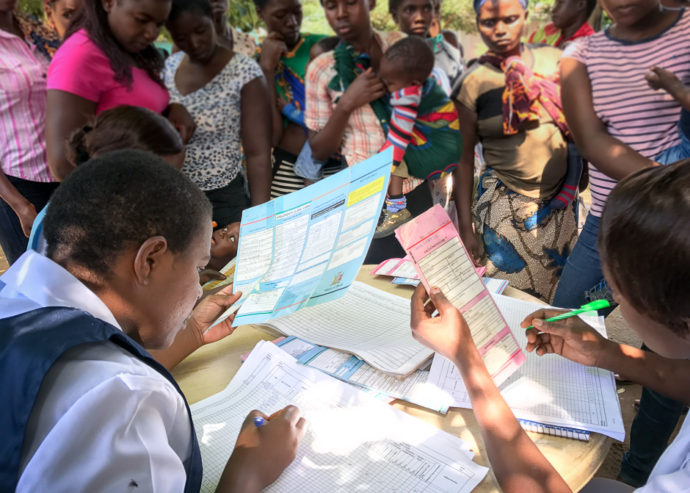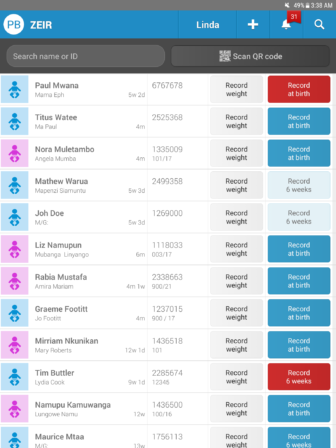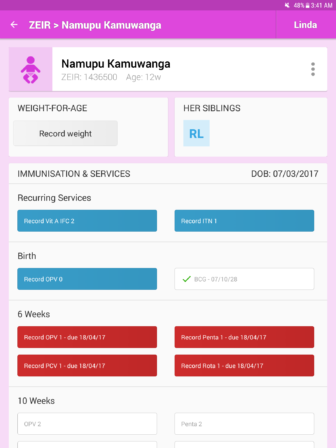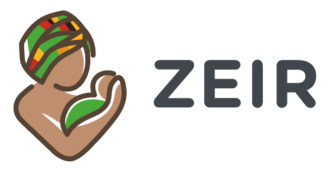An inside look at Zambia’s new electronic immunization registry
The following was originally written for and posted on the BID Initiative blog. It provides an update on the Zambian electronic immunization registry we’re building with Path, which we introduced in a previous post.

Photo: Ona. Zambia’s paper-based immunization reporting systems of the past, are time-intensive and often result in longer wait times for patients.
Back in February, I wrote about Ona’s visit to Livingstone, Zambia to work with PATH’s BID Initiative, the nurses in the health facilities, and other project stakeholders to collectively define a health information system that would ease the data collection and reporting burden of the nurses, while at the same time making their data more accessible and useful to them during their work. Coming home from that visit, we had a pretty good understanding of what the nurses’ pain points are, mostly around data entry and reporting requirements. After a rapid and iterative development phase, the app’s first release was launched in April and given to nurses from six health facilities in Livingstone District for the first phase of testing.
The app, powered by OpenSRP, is known as ZEIR, which stands for Zambia Electronic Immunization Registry. I visited Livingstone shortly after the nurses from the initial six facilities started using the app and was struck by how easily they picked up the application. Many of the nurses remarked that they already felt the app would reduce their workload once their current paper system was replaced. This week, Ona will release the next version of the app, as it scales in Kazungula and other districts in Southern Province, in partnership with the BID Initiative and the government of Zambia. The aim is to scale to 267 facilities across the province by February of 2018.
Zambia’s immunization registry goes digital: ZEIR in action

The home register view is where children appear after the user fills out the birth registration form.
The ZEIR application supports nurse workflows around childhood vaccination and growth monitoring. Each nurse has a unique login to the ZEIR app, and health workers from the same facility can easily log in and out of a shared device to access the health facility’s data, even without an internet connection.
Because the electronic registry represents a learning curve for most health workers who have relied on a paper system for much of their careers, the user interface was designed to resemble familiar paper forms. Children are registered in the app with a simple birth registration form, and the nurse can immediately record vaccines and weight in the system, which mimics the look of the paper vaccine cards that mothers carry with them.
The Zambian vaccine schedules are added to the app and appear as color-coded reminders, alerting the nurse to services that are due or overdue. Nurses can also view the complete record for the child and edit the child’s demographic details from the more detailed profile view.

The mockup of this vaccine card view mimics the look of a child’s paper vaccine card. The nurse can record vaccines and weight here.
One important workflow that was emphasized early on is that of providing services to children coming from outside the facility’s catchment area, that is, patients who may come from neighboring districts or facilities to receive services. For this, the team developed a feature to allow nurses to do a “global database” lookup, so they can search for children who may have been registered from other facilities. Since the app had to support all of these workflows in offline mode as well, we developed an offline form for recording services provided to children visiting from outside the facility’s catchment area too.
It’s not uncommon for as many as 150 children to show up at an end-of-month immunization clinic. Watching health workers use the app for the first time, it was easy to see how, even with a digital registry, high-volume health facilities may struggle to keep up with their patients. To avoid backlogs from nurses having to register all of the children in the app during the immunization clinic, we created a way to bulk import their existing data into the app. Also helpful is the ZEIR’s “record all” feature, which allows nurses to mark multiple vaccines given at once, instead of requiring that they enter each individually. The feature saves them time, so nurses can get on with their work: weighing and vaccinating children.
Looking ahead
From the beginning, the BID Initiative together with the government of Zambia, emphasized the need for local ownership and Ona adapted the app specifically to Zambia’s health system. This is reflected in the logo that was designed for the project, which features the Zambian flag’s colors on the profile of a woman holding her child. The project rollout plan is ambitious, with the aim to scale to 267 facilities by February of next year, so establishing a local connection to the system and retaining a sense of ownership is key.

The ZEIR logo displays the Zambian flag colors and enhances project ownership.
The hard work is by no means over. The Ona team is working to add the remaining features to the app. Next up: a stock reporting module, plotting growth charts, and automated reporting that will transmit data directly from the app into Zambia’s national health information system. New service workflows for vitamin A, deworming, and insecticide-treated bednet (ITN) distribution are also in progress as part of the health management information system reporting. The BID Initiative, in partnership with the Ministry of Health, will continue providing support to the nurses currently using the app while also taking the system to new health facilities across Southern Province and training new nurses.
For me, the best part of my work is being able to watch health workers use the products that we have built for them, especially seeing the moment when they realize the impact it will have on their work. We strive to deliver products that health workers deserve to use; products that will make their work easier, more efficient, and that will have a real impact on the lives of their patients. I am looking forward to the next phase of this project.

